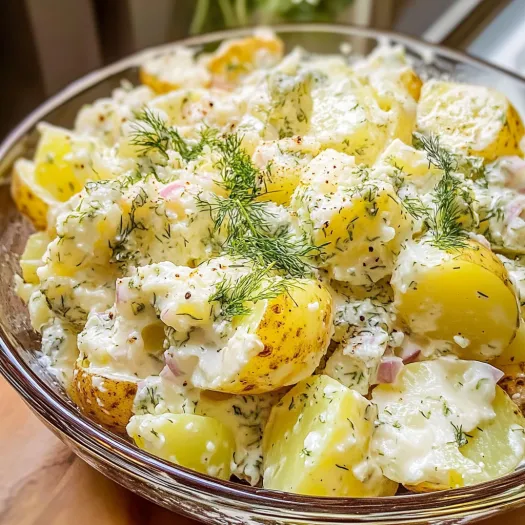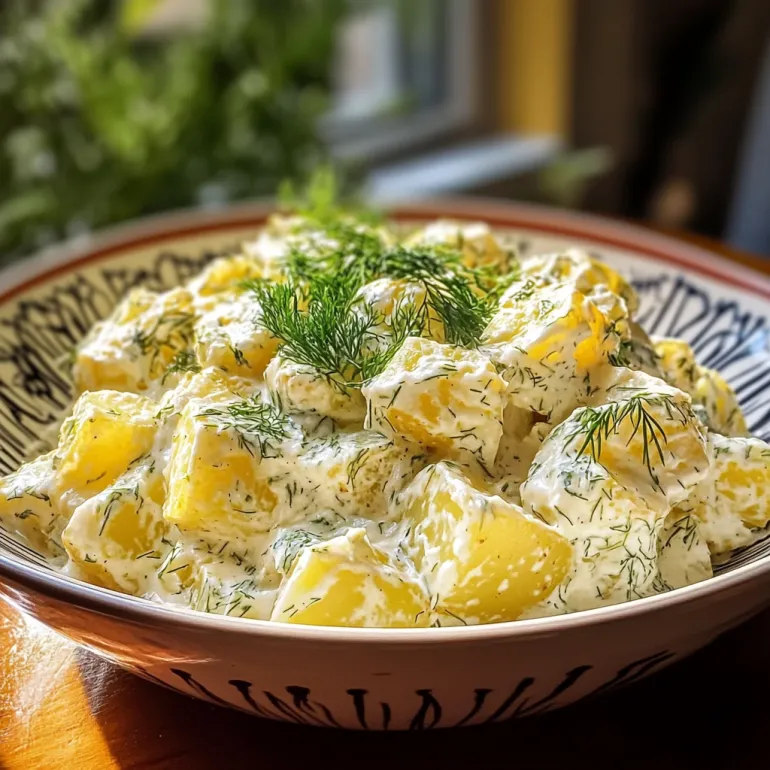 Pin
Pin
This dill potato salad brings together tender potatoes, crunchy vegetables, and a creamy herb-infused dressing for the perfect warm weather side dish. The fresh dill infuses every bite with bright, aromatic flavor while the combination of mayonnaise and yogurt creates a balanced, tangy dressing that clings perfectly to each potato chunk.
I discovered this potato salad recipe during a summer cookout marathon when I needed something that would please both my vegan cousin and mayo-loving uncle. Three years later, it's now requested at every family gathering regardless of season.
Ingredients
- Potatoes: Choose waxy varieties like Yukon Gold or red potatoes as they hold their shape better after boiling
- Celery: Adds essential crunch and subtle flavor that balances the creamy elements
- Radishes: Provides a peppery bite and beautiful color contrast
- Red onion: Contributes sharp flavor that mellows as it marinates in the dressing
- Dill pickles: Secret ingredient that adds acidity and briny goodness throughout
- Fresh dill: The star herb that makes this salad distinctive and memorable
- Mayonnaise: Creates the creamy base; traditional or vegan varieties work equally well
- Greek yogurt: Lightens the dressing while adding protein and tangy flavor
- Apple cider vinegar: Brightens all flavors and helps potatoes absorb more flavor
- Mustard: Adds depth and subtle heat to the dressing
Step-by-Step Instructions
- Boil the Potatoes:
- Start with cold water for even cooking and add salt only after the water boils to prevent potato skin from breaking down. Cook until a fork slides in easily but the potatoes still hold their shape, about 20 to 30 minutes depending on potato size. The potatoes should be tender throughout but not mushy.
- Prepare for Flavor Absorption:
- While still warm, peel and cut potatoes into bite-sized chunks allowing steam to escape. Immediately sprinkle with apple cider vinegar which potatoes will absorb as they cool, boosting their flavor from the inside out. This step alone elevates your potato salad from good to exceptional.
- Mix the Dressing:
- Combine all dressing ingredients in a bowl, whisking until completely smooth. The fresh dill should be finely chopped to distribute its flavor evenly throughout the mixture. Taste and adjust seasonings if needed; the dressing should taste slightly more seasoned than you want the final salad to be.
- Combine Components:
- In a large bowl, gently mix potatoes with all vegetables, tossing carefully to maintain potato integrity. Pour dressing over the mixture and fold gently until everything is evenly coated with no dry spots remaining.
- Chill and Develop Flavors:
- Refrigerate for at least one hour before serving, though overnight is even better. This resting period allows flavors to meld and vegetables to slightly pickle in the dressing for the most delicious result.
 Pin
Pin
The first time I served this at a neighborhood block party, one neighbor approached me privately for the recipe saying it reminded her of her grandmother's potato salad but with a modern twist. The fresh dill truly transforms an everyday dish into something special that creates memories.
Storage Tips
This potato salad will keep beautifully in an airtight container in the refrigerator for up to four days. The flavors actually continue developing over time, making it an ideal make-ahead dish. If storing longer than two days, consider saving some fresh dill to sprinkle over the top just before serving for a bright flavor boost.
Flavor Variations
While dill is the signature herb in this recipe, you can create different flavor profiles by substituting other herbs. Try fresh parsley and chives for a classic approach or add chopped tarragon for a French-inspired twist. For a Mediterranean version, incorporate olives, capers, and use lemon juice instead of vinegar in the dressing.
Serving Suggestions
This potato salad shines alongside grilled proteins like chicken, sausages, or plant-based burgers. For a complete meal, serve it with a simple green salad and crusty bread. At potlucks, position it next to spicier dishes where its creamy texture provides welcome contrast. For an elegant presentation, serve in individual portions topped with a sprig of fresh dill and a light dusting of smoked paprika.
Making It Lighter
For a less calorie-dense version, substitute more Greek yogurt for some of the mayonnaise. The tanginess of yogurt complements the dill beautifully while reducing the overall fat content. You can also increase the proportion of crunchy vegetables to potatoes for a higher fiber dish with fewer carbohydrates per serving.
 Pin
Pin
Frequently Asked Questions About the Recipe
- → Can I make this potato salad ahead of time?
Yes! This dill potato salad actually improves when made ahead. Prepare it up to 24 hours in advance and refrigerate for the flavors to develop fully. Just give it a quick stir before serving.
- → What type of potatoes work best for this salad?
Waxy potatoes like Yukon Gold or red potatoes are ideal as they hold their shape after boiling. Russets tend to break down more easily, though they can be used if you prefer a slightly mashier texture in your salad.
- → Is there a dairy-free option for this salad?
Absolutely! As noted in the ingredients, you can use vegan mayo and non-dairy yogurt (like coconut or almond-based varieties) for a completely dairy-free version that maintains all the creamy texture and flavor.
- → Why do you add vinegar to the warm potatoes?
Adding apple cider vinegar to the warm potatoes allows them to absorb the tangy flavor while cooling. This step enhances the overall taste profile and ensures the dressing isn't diluted later when the potatoes release moisture.
- → How long will this potato salad keep in the refrigerator?
When stored in an airtight container in the refrigerator, this potato salad will keep well for 3-4 days. The flavors may continue to develop, but the vegetables might lose some crispness after day 2.
- → Can I substitute dried dill for fresh?
Yes, though fresh dill provides the best flavor. If using dried dill, reduce the amount to about 1 tablespoon since dried herbs are more concentrated. You might also want to let the dressing sit longer before mixing to allow the dried herbs to rehydrate.
